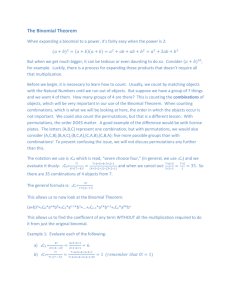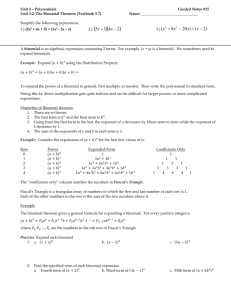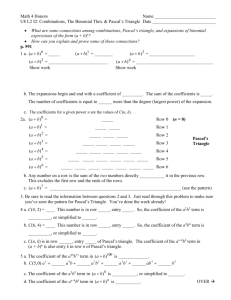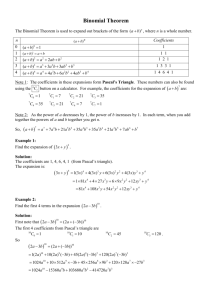The Binomial Theorem
advertisement
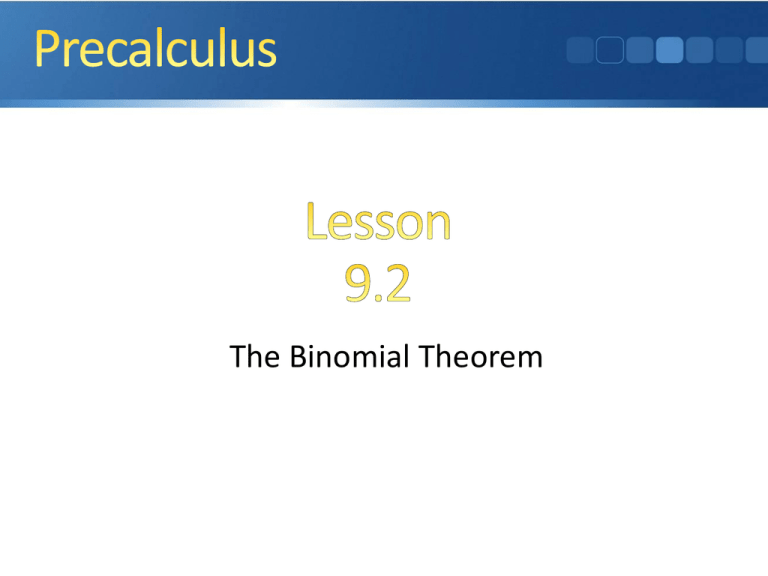
The Binomial Theorem
Use the distributive property to expand the binomial.
2
2
(
x
y
)(
x
y
)
x xy yx y
1. x y
2
x 2 xy y
2
2
2
2
(
a
2
b
)(
a
2
b
)
a 2ab 2ba (2b)
2. (a 2b)
2
a 2 4ab 4b 2
3. (2c 3d ) (2c)2 6cd 6dc (3d ) 2
2
4c 12cd 9d
2
4. (2 x y ) (2 x)2 2 xy 2 yx ( y) 2 4 x 2 4 xy y 2
2
2 2
2
5. x y ( x y)2 ( x y) (xx3 232xxy
y 3yxy)( xyy3)
3
2
Powers of Binomials
Pascal’s Triangle
The Binomial Theorem
Factorial Identities
… and why
The Binomial Theorem is a marvelous study in
combinatorial patterns.
The binomial coefficients that appear
in the expansion of (a b)
are the values of C for r 0,1, 2,3,..., n.
n
n
r
A classical notation for C ,
n
r
especially in the context of binomial
n
coefficients, is .
r
Both notations are read "n choose r."
Expand a b , using a calculator to compute the binomial coefficients.
4
Enter nCr(4,{0,1,2,3,4})
Enter 4 nCr {0,1,2,3,4}
This finds the binomial coefficients for n = 4.
The calculator gives the list {1, 4, 6, 4, 1}.
Using these coefficients, construct the expansion:
a b
4
a 4a b 6a b 4ab b .
4
3
2
2
3
4
The triangle starts with a pyramid of 1’s.
To make a new row, you add 2 entries in the previous row together
and put the answer underneath and between the previous entries.
You sandwich each row with 1’s.
1
1 1
1 2 1
1 3 3 1
1 4 6 4 1
1 5 10 10 5 1
When you count rows or entries, start with 0.
1
Row 0
1 1
Row 1
1 2 1
Row 2
1 3 3 1
Row 3
1 4 6 4 1
Row 4
1 5 10 10 5 1
Row 5
0 1 2
3 4 5
Position
If I ask for 5C3, I go to row 5 and choose the 3rd entry
Pascal’s triangle can be used for combinatoric problems. These
are problems where you want to see how many different ways
you choose a subset from a full group. For example, choosing
3 students from a group of 5.
This is fine for small problems, but isn’t so nice for big ones.
How many different ways can I draw 5 cards from a deck of
52? It’s just the 5th entry on the 52nd row of the triangle. OR
we can use a formula.
n
n!
n Cm
m ! n m !
m
This isn’t quite the same as a poker hand, since poker only cares
about suites when you look at a flush, but you’ll get the idea.
If I want to see how many unique combinations of 5 cards I can
make from a deck of 52, then I need 52C5.
52
52!
52!
5 5! 52 5 ! 5!47!
Tip: count the top down to the larger of the 2 numbers in the bottom, then
reduce. Only count down the small one in the denominator.
52 51 50 49 48 47!
5 4 3 2 1 47!
The 47! will cancel and you can reduce in the
rest of the fraction will reduce like normal.
Then just multiply whatever is left.
2,598,960 That’s a lot of different hands!
Pascal’s triangle can also be used for binomial expansion. The
exponent tells you what row to go to and the row entries are
the coefficients.
1
1 1
x y
4
1x 4 y 0 4 x 3 y 1 6 x 2 y 2 4 x 1 y 3 1 x 0 y 4
x 4 4 x3 y 6 x 2 y 2 4 xy 3 y 4
1 2 1
1 3 3 1
1 4 6 4 1
1 5 10 10 5 1
The coefficients (blue) come from the triangle.
The red part is never written, but notice how
the exponents count down for x and up for y.
1. Copy the coefficients for the row that matches
your exponent.
2. Let the exponent on the first term count down
to 0.
3. Let the exponent on the second term count up
from 0.
4. If the sign is +, then they are all +
5. If the sign is -, then they alternate + and -.
Expand 2 x 3 y
5
1. Take the coefficients from row 5.
1 5 10 10 5 1
2. The (2x) starts with an exponent of 5 and counts down.
1(2x)5
5(2x)4 10(2x)3
10(2x)2
5(2x)1
1(2x)0
3. The (3y) starts with an exponent of 0 and counts up.
1(2x)5(3y)0 5(2x)4(3y)1 10(2x)3(3y)2 10(2x)2(3y)3 5(2x)1(3y)4 1(2x)0(3y)5
4. Since it’s a minus in the middle, we alternate + and – signs.
1(2x)5(3y)0 - 5(2x)4(3y)1 + 10(2x)3(3y)2 - 10(2x)2(3y)3 + 5(2x)1(3y)4 - 1(2x)0(3y)5
5. Now we clean it up. Remember that order of operations
says exponents before multiplication.
1(32x5)(1)- 5(16x4)(3y)1 + 10(8x3)(9y2) - 10(4x2)(27y3) + 5(2x)(81y4) - 1(1)(243y5)
32 x5 240 x 4 y 720 x3 y 2 1080 x 2 y3 810 xy 4 243 y 5
It’s not much fun, but it beats doing
this:
5
2x 3y
2 x 3 y 2 x 3 y 2 x 3 y 2 x 3 y 2 x 3 y
Enter expand((2x – 3y)^5, x)
Be sure your variables are not already assigned a value!!!!
n n 1 n 1
r r 1 r
or, equivalently,
n
C C C
r
n 1
r 1
n 1
r
Find the coefficient of x8 in the expansion of ( x 2)11.
The only term in the expansion that we need to deal with is
C8 x (2)
8
11
3
11!
(2)3 x8 165 (2)3 x8 1320x8
8!3!
The coefficient is −1320.
For any positive integer n,
n
n
n
n
a b a a b ... a b ... b ,
0
1
r
n
n
n!
where C
.
r !(n r )!
r
n
n
n
r
n 1
nr
r
n
Expand 2 x 3 y
2 5
We use the Binomial Theorem to expand (a b)5
where a 2 x and b 3 y 2 .
(a b)5 a5 5a 4b 10a3b2 10a 2b3 5ab4 b5
(2 x 3 y 2 )5 (2 x)5 5(2 x)4 ( 3 y 2 ) 10(2 x)3 ( 3 y 2 )2
10(2 x)2 ( 3 y 2 )3 5(2 x)( 3 y 2 )4 ( 3 y 2 )5
32 x 240 x y 720 x y 1080 x y 810 xy 243 y
5
4
2
3
4
2
6
8
10
For any integer n 1,
n! n n 1!
For any integer n 0,
n 1! n 1 n!
Text pg715
Exercises
# 2-26 even


